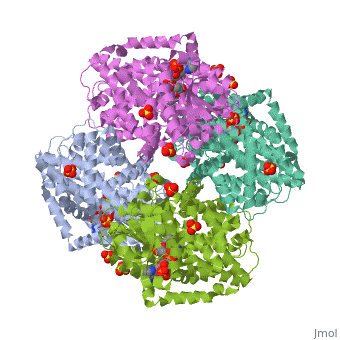Ketol-acid reductoisomerase
From Proteopedia
(Difference between revisions)
(New page: <StructureSection load='3ulk' size='340' side='right' caption='E. coli class II ketol-acid reductoisomerase complex with NADPH and Mg+2 ion (PDB code 3ulk) ' scene=''> '''Ketol-acid r...) |
|||
| Line 1: | Line 1: | ||
| - | + | <StructureSection load='3ulk' size='340' side='right' caption='E. coli class II ketol-acid reductoisomerase complex with NADPH, sulfate and Mg+2 ion (PDB code [[3ulk]]) ' scene=''> | |
| - | <StructureSection load='3ulk' size='340' side='right' caption='E. coli class II ketol-acid reductoisomerase complex with NADPH and Mg+2 ion (PDB code [[3ulk]]) ' scene=''> | + | |
'''Ketol-acid reductoisomerase''' (KARI) is a bifunctional enzyme which catalizes two steps in the biosynthesis of branched-chain amino acids. KARI catalyzes the isomerization of alkyls and the NADPH-dependent reduction of a 2-ketoacid. There are two forms of KARI. A short form – Class I – found in fungi and most bacteria and a long form – Class II – found in plants. | '''Ketol-acid reductoisomerase''' (KARI) is a bifunctional enzyme which catalizes two steps in the biosynthesis of branched-chain amino acids. KARI catalyzes the isomerization of alkyls and the NADPH-dependent reduction of a 2-ketoacid. There are two forms of KARI. A short form – Class I – found in fungi and most bacteria and a long form – Class II – found in plants. | ||
Revision as of 06:22, 29 July 2015
| |||||||||||
3D Structures of Ketol-acid reductoisomerase
Updated on 29-July-2015

